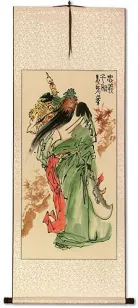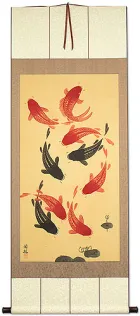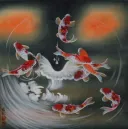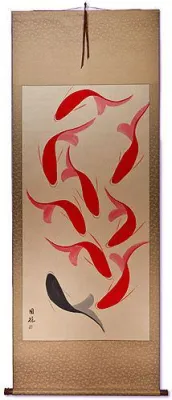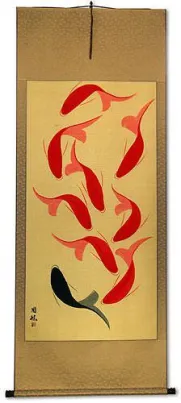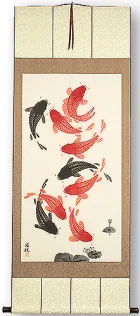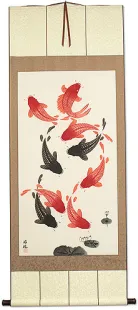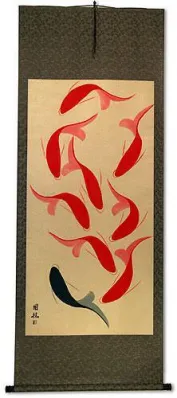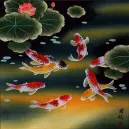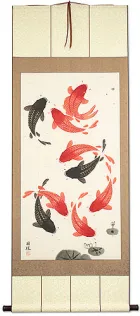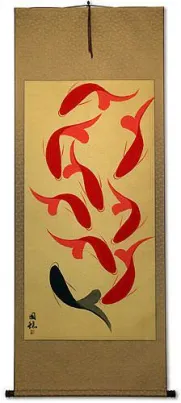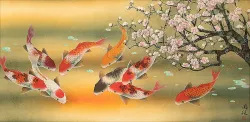Many custom options...
And formats...

Nine Years in Chinese / Japanese...
Buy a Nine Years calligraphy wall scroll here!
Personalize your custom “Nine Years” project by clicking the button next to your favorite “Nine Years” title below...
Facing the Wall Nine Years
面壁九年 is a Buddhist term that means “facing a wall for nine years.”
This refers to the Bodhidharma who stared at a wall in meditation at the Shaolin Temple (or in a cave) for nine years until reaching full enlightenment.
Shaolin Temple
少林寺 is the full title of the Shaolin Temple.
This refers to the Buddhist monastery famous for its kung fu monks.
少林寺 is also known in Japanese, where they use the same characters but romanize them as Shourinji or Shōrinji.
Some believe this monastery and temple represent where Bodhidharma sat with his face to a wall for nine years, leading to his discovery of enlightenment and the establishment of Buddhism in China.
This in-stock artwork might be what you are looking for, and ships right away...
Gallery Price: $200.00
Your Price: $88.88
Gallery Price: $500.00
Your Price: $298.88
Gallery Price: $160.00
Your Price: $88.88
Gallery Price: $718.00
Your Price: $398.88
Not the results for nine years that you were looking for?
Below are some entries from our dictionary that may match your nine years search...
| Characters If shown, 2nd row is Simp. Chinese |
Pronunciation Romanization |
Simple Dictionary Definition |
少林寺 see styles |
shào lín sì shao4 lin2 si4 shao lin ssu shourinji / shorinji しょうりんじ |
More info & calligraphy: Shaolin Temple(place-name) Shaolin Temple (China); Shourinji The monastery at 少室 in 登封 Dengfeng xian, Henanfu, where Bodhidharma sat with his face to a wall for nine years. |
面壁九年 see styles |
miàn bì jiǔ nián mian4 bi4 jiu3 nian2 mien pi chiu nien menpekikunen めんぺきくねん |
More info & calligraphy: Facing the Wall Nine Yearsnine years facing the wall |
上座 see styles |
shàng zuò shang4 zuo4 shang tso kamiza; jouza / kamiza; joza かみざ; じょうざ |
seat of honor (n,vs,adj-no) chief seat; seat of honor; seat of honour; head of the table; (place-name) Jōza Sthavira; or Mahāsthavira. Old man, or elder; head monk, president, or abbot; the first Buddhist fathers; a title of Mahākāśyapa; also of monks of twenty to forty-nine years standing, as 中座 are from ten to nineteen and 下座 under ten. The 釋氏要覽 divides presiding elders into four classes, those presiding over monasteries, over assemblies of monks, over sects, and laymen presiding over feasts to monks. |
壁觀 壁观 see styles |
bì guān bi4 guan1 pi kuan hekkan |
The wall-gazer, applied to Bodhidharma, who is said to have gazed at a wall for nine years. Also a name for the meditation of the Chan school. |
達磨 达磨 see styles |
dá mó da2 mo2 ta mo daruma(p); daruma だるま(P); ダルマ |
(1) (kana only) daruma; tumbling doll; round, red-painted good-luck doll in the shape of Bodhidharma, with a blank eye to be completed when a person's wish is granted; (2) (kana only) Bodhidharma; (3) prostitute; (personal name) Daruma dharma; also 達摩; 達麼; 達而麻耶; 曇摩; 馱摩 tr. by 法. dharma is from dhara, holding, bearing, possessing, etc.; and means 'that which is to be held fast or kept, ordinance, statute, law, usage, practice'; 'anything right.' M.W. It may be variously intp. as (1) characteristic, attribute, predicate; (2) the bearer, the transcendent substratum of single elements of conscious life; (3) element, i.e. a part of conscious life; (4) nirvāṇa, i.e. the Dharma par excellence, the object of Buddhist teaching; (5) the absolute, the real; (6) the teaching or religion of Buddha; (7) thing, object, appearance. Also, Damo, or Bodhidharma, the twenty-eighth Indian and first Chinese patriarch, who arrived in China A.D. 520, the reputed founder of the Chan or Intuitional School in China. He is described as son of a king in southern India; originally called Bodhitara. He arrived at Guangdong, bringing it is said the sacred begging-bowl, and settled in Luoyang, where he engaged in silent meditation for nine years, whence he received the title of wall-gazing Brahman 壁觀婆羅門, though he was a kṣatriya. His doctrine and practice were those of the 'inner light', independent of the written word, but to 慧可 Huike, his successor, he commended the Laṅkāvatāra-sūtra as nearest to his views. There are many names with Dharma as initial: Dharmapāla, Dharmagupta, Dharmayaśas, Dharmaruci, Dharmarakṣa, Dharmatrāta, Dharmavardhana, etc. |
面壁 see styles |
miàn bì mian4 bi4 mien pi menpeki めんぺき |
to face the wall; to sit facing the wall in meditation (Buddhism); (fig.) to devote oneself to study, work etc (n,vs,vi) meditation facing a wall; (surname) Omokabe To sit in meditation with the face to a wall, as did Bodhidharma for nine years, without uttering a word. |
九か年 see styles |
kyuukanen / kyukanen きゅうかねん |
(can act as adjective) novennial; recurring every nine years |
九ヶ年 see styles |
kyuukanen / kyukanen きゅうかねん |
(can act as adjective) novennial; recurring every nine years |
九箇年 see styles |
kyuukanen / kyukanen きゅうかねん |
(can act as adjective) novennial; recurring every nine years |
化地部 see styles |
huà dì bù hua4 di4 bu4 hua ti pu Keji bu |
Mahīśāsakah, 磨醯奢婆迦部; 彌喜捨婆阿; 彌婆塞部, 正地部 an offshoot from the 說一切有部 or Sarvāstivāda school, supposed to have been founded 300 years after the nirvana. The name Mahisasakah is said to be that of a ruler who 'converted his land' or people; or 正地 'rectified his land'. The doctrines of the school are said to be similar to those of the 大衆部 Mahāsāṅghika; and to have maintained, inter alia, the reality of the present, but not of the past and future; also the doctrine of the void and the non-ego; the production of taint 染 by the five 識 perceptions; the theory of nine kinds of non-activity, and so on. It was also called 法無去來宗 the school which denied reality to past and future. |
九年面壁 see styles |
jiǔ nián miàn bì jiu3 nian2 mian4 bi4 chiu nien mien pi kunen menpeki |
nine years facing the wall |
昭和一桁 see styles |
shouwahitoketa / showahitoketa しょうわひとけた |
(generation born in) the first nine years of the Shōwa period (1926-1934) |
鬱多羅究留 郁多罗究留 see styles |
yù duō luó jiū liú yu4 duo1 luo2 jiu1 liu2 yü to lo chiu liu |
Uttarakuru, also 鬱多羅拘樓; 鬱多羅鳩婁; 郁多羅拘樓; 郁恒羅拘瑠; 郁恒羅越; 郁軍越, etc. The northern of the four continents around Meru, square in shape, inhabited by square-faced people; explained by 高上作 superior to or higher than other continents, 勝 superior, 勝生 superior life, because human life there was supposed to last a thousand years and food was produced without human effort. Also, the dwelling of gods and saints in Brahmanic cosmology; one of the Indian 'nine divisions of the world, the country of the northern Kurus. situated in the north of India, and described as the countπy of eternal beatitude.' M. W. |
Variations: |
kokonotsu ここのつ |
(numeric) (1) nine; (2) nine years of age; (3) twelve o'clock (old time system) |
Variations: |
kyuukanen / kyukanen きゅうかねん |
(can act as adjective) novennial; recurring every nine years |
The following table may be helpful for those studying Chinese or Japanese...
| Title | Characters | Romaji (Romanized Japanese) | Various forms of Romanized Chinese | |
| Facing the Wall Nine Years | 面壁九年 | menpeki kyunen menpekikyunen | miàn bì jiǔ nián mian4 bi4 jiu3 nian2 mian bi jiu nian mianbijiunian | mien pi chiu nien mienpichiunien |
| Shaolin Temple | 少林寺 | shou rin ji shourinji sho rin ji | shào lín sì shao4 lin2 si4 shao lin si shaolinsi | shao lin ssu shaolinssu |
Successful Chinese Character and Japanese Kanji calligraphy searches within the last few hours...


